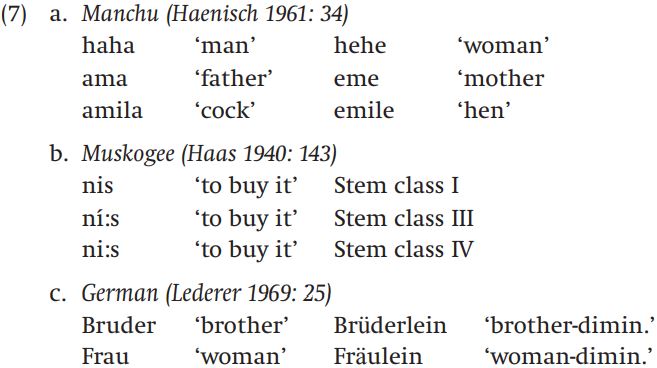


 Grammar
Grammar
 Tenses
Tenses
 Present
Present
 Past
Past
 Future
Future
 Parts Of Speech
Parts Of Speech
 Nouns
Nouns
 Verbs
Verbs
 Adverbs
Adverbs
 Adjectives
Adjectives
 Pronouns
Pronouns
 Pre Position
Pre Position
 Preposition by function
Preposition by function 
 Preposition by construction
Preposition by construction
 Conjunctions
Conjunctions
 Interjections
Interjections
 Grammar Rules
Grammar Rules
 Linguistics
Linguistics
 Semantics
Semantics
 Pragmatics
Pragmatics
 Reading Comprehension
Reading Comprehension|
Read More
Date: 2023-10-02
Date: 27-1-2022
Date: 24-1-2022
|
Internal stem change
Most of the forms of lexeme formation that we’ve looked at so far have involved adding something to a base (or combining bases).1 Some languages, however, have means of lexeme formation that involve changing the quality of an internal vowel or consonant of a base, root, or stem; sometimes this internal change occurs alone, and sometimes in conjunction with affixation of some sort. Such processes are called internal stem change or apophony.
Example (7) gives some words where internal vowels change:

In Manchu, in forming the female equivalent of a male noun, back vowels become front vowels. In Muskogee, verb stems have five forms each of which can be used in a number of verbal contexts (completive, incompletive, durative, and so on). Three of these forms are differentiated by the length and tonal patterns on their vowels. For class I, stems have short vowels and no special tonal accent. Class III stems have long vowels and falling tonal accents, and class IV have long vowels and no special accent. Morphological processes that affect the quality, quantity, or tonal patterns of vowels are often referred to as ablaut.
In German, when certain suffixes like the diminutive suffix -lein are added to a stem, the stem vowel becomes a front vowel. Historically, this fronting was a phonological process that occurred when a following suffix itself contained a front vowel; this process is called umlaut. Over time, the front vowels were lost in some suffixes or became back vowels, as is the case with the diminutive suffix -lein (pronounced [lain]).
|
|
|
|
علامات بسيطة في جسدك قد تنذر بمرض "قاتل"
|
|
|
|
|
|
|
أول صور ثلاثية الأبعاد للغدة الزعترية البشرية
|
|
|
|
|
|
|
مكتبة أمّ البنين النسويّة تصدر العدد 212 من مجلّة رياض الزهراء (عليها السلام)
|
|
|